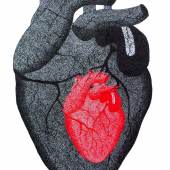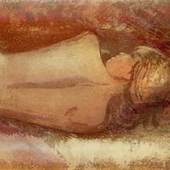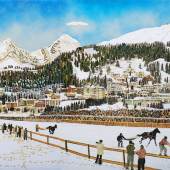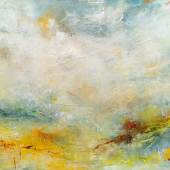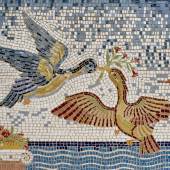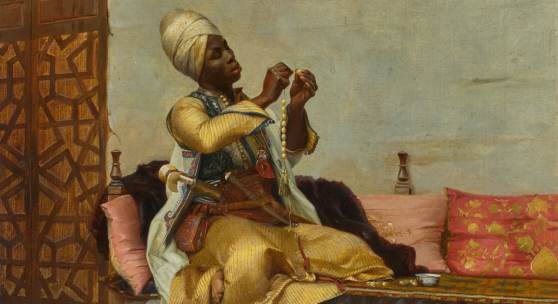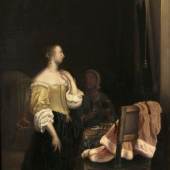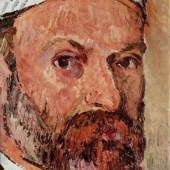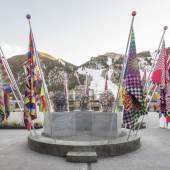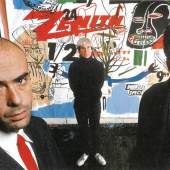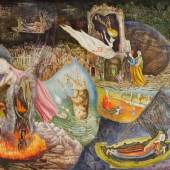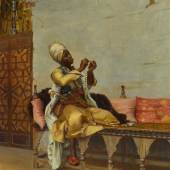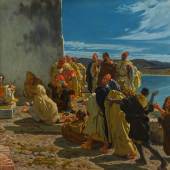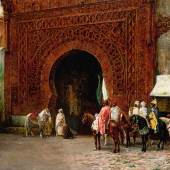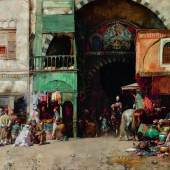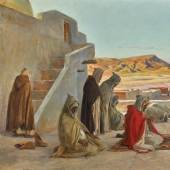The Orientalist Sale Pulls In to London / مزاد المستشرقين يصل على لندن
-
Auktion24.04.2018
In this rediscovered panoramic view, animated figures crowd around the Sultan’s sage or fortune teller on the steps of the gate of the Kasbah in Tangiers. Dehodencq moved to Morocco by way of Spain in 1853, and settled there from 1854 until 1863, during which time he produced many of his most famous paintings of Moroccan life. All of them are distinguished by their intense colour palette and sense of dramatic movement. This work was probably acquired by its first owner, Sir John Hay- Drummond-Hay, while he was serving in Tangiers, and it has remained in the Drummond-Hay family ever since.
Paul Joanowits (Serbian, 1859 – 1957) Bashi-bazouks before a Gateway, oil on panel Estimate £100,000-150,000 / $140,000-210,000 Bashi-bazouks were irregulars in the Ottoman army and hailed from lands across the Ottoman empire, from Egypt to the Balkans. The two soldiers, in all their regalia, converse in an Egyptian setting, the gate topped by Mamluk carvings and flanked by East African ‘Grandees’ chairs’, amalgams of Mamluk, Portuguese, and Indian influence. Both men are armed with Ottoman flintlock rifles from Algeria, and the standing guard smokes an Ottoman chibouk pipe with a tophane bowl. On the left, a seventeenth-century Ottoman Tulip-period Tombak ewer rests on the arm of one of the chairs.
Jean Discart (French, 1844 – 1944) The Cobbler, oil on panel Estimate £150,000-200,000 / $210,000-280,000
Discart captures his subject, a cobbler watched by his companion, in a moment of rapt concentration, conveyed by his expression and expert  hand. The craftsman is surrounded by objects and products of his trade painted in exquisite detail: all manner of babouche slippers, a pair of soft kidd boots, and his stitching kit. The result is a fascinating evocation of a Moroccan street scene, with references to the town’s architecture in the form of the white washed houses and a magnificent riveted copper door. Along with Ludwig Deutsch and Rudolf Ernst, Discart established himself as one of the foremost Vienna-trained Orientalist painters of his day.
Alberto Pasini (Italian, 1826 – 1899) Market in Constantinople, oil on canvas Estimate £150,000-200,000 / $210,000-280,000
Market in Constantinople epitomises Pasini’s carefully observed, naturalistic market scenes, capturing the hustle and bustle and diversity of the mercantile city. The composition is distinguished as much by the artist’s fine draughtsman as by the vivid palette, punctuated by brilliant turquoises, pinks, and greens. The exact setting is not known, however it may have been inspired by the entrance to the Mısır Çarşısı, also called the Egyptian or Spice Bazaar. Pasini first travelled to Constantinople on his landmark journey to the East in 1855, which began his career as an Orientalist painter. In this work Pasini deploys his observations of life in the Ottoman Empire: traders setting out their wares, tethered horses, a rider emerging from the shadow of the gate, and groups in animated discussion or negotiation.
Eugène Girardet (French, 1853 – 1907) Evening Prayers, oil on canvas Estimate £150,000-200,000 / $210,000-280,000
Scenes of prayer occupy a central position in nineteenth-century Orientalist art. Evening Prayers is not only a splendid evocation of the North African desert, but affords a fascinating glimpse into the rituals of Muslim worship. In the cool shade cast by the building behind them, a group of men on a rooftop face Mecca in prayer. In 1874, Girardet embarked for Morocco, then travelled to Tunisia and Algeria, for which he developed a particular fondness. He spent subsequent visits in Algiers and Boghari, but above all in El Kantara and Bou-Saâda, in the foothills of the Saharan Atlas, painting scenes of daily life.
Charles Wilda (German, 1854 – 1907) A Souk in Cairo, 1887, oil on panel Estimate £120,000-180,000 / $168,000-252,000
Painted in 1887, this street view of Cairo is a striking example of the nineteenth- century Orientalist views which opened up a new world to European viewers. The hustle and bustle of women carrying water jugs and snake charmers, rendered with photographic realism, brilliantly evoked the souks and streets of a city beyond the reach of many. In the background, the striated red and white brick buildings so typical of the Egyptian capital inspired artists and architects alike. Like many of his fellow Orientalist painters, Wilda travelled to Egypt in the early 1880s and set up a studio in Cairo where he developed a keen interest for the depiction of everyday Egyptian life. 
Rudolf Ernst (Austrian, 1854-1932) The Fountain of Ahmed III, Constantinople, oil on panel Estimate £80,000-120,000 / $112,000-168,000
Set just outside the gates of Constantinople’s Topkapı Palace, the fountain of Ahmed III was built in 1728-9, during the Tulip Era (so- called because of the popularity of this flower and the flourishing of the arts in the Ottoman Empire between 1718 and 1730). There are water taps set into the shallow niches on each of the four sides, and at each corner is a sebil, or kiosk, where drinking water was dispensed in cups to passers-by. Each sebil has three tall windows which, as Ernst’s painting attests, are covered with elaborate bronze lattices. Erected across the city as acts of charity by notable families, these monuments soon became the favourite gathering places of traders, travellers, and townspeople. Ernst travelled to Constantinople in the 1870s and would have been familiar with this - even at that time - famous site.
Rudolf Ernst (Austrian, 1854 – 1932) Tending the Lamp, oil on panel Estimate £100,000-150,000 / $140,000-210,000
-
14.09.2019Anita Rée gehört zu den Künstlerinnen, die sich auf dem Kunstmarkt durchgesetzt haben. Ihr Talent...
-
Gegen Ende seine Lebens malt und zeichnet Cézanne wiederholt das Motiv der "Badenden"....
-
20.04.2024 - 24.11.2024Jeffrey Gibson on Representing the United States and Himself By Melissa Smith | Feb 16, 2024 From...
-
13.05.2024 - 15.05.2024Sotheby’s Sealed is thrilled to present this spectacular Mercedes-Benz 300 SL Alloy...
-
14.05.2024Warhol & Basquiat’s Collaboration Series Masterwork To Highlight Sotheby’s...
-
15.05.2024T he most significant work by the celebrated Surrealist artist Leonora Carrington, Les...
-
24.04.2018Auktion »
AUCTION 18 APRIL IN NEW YORK
Public Exhibition Opens 13 April
